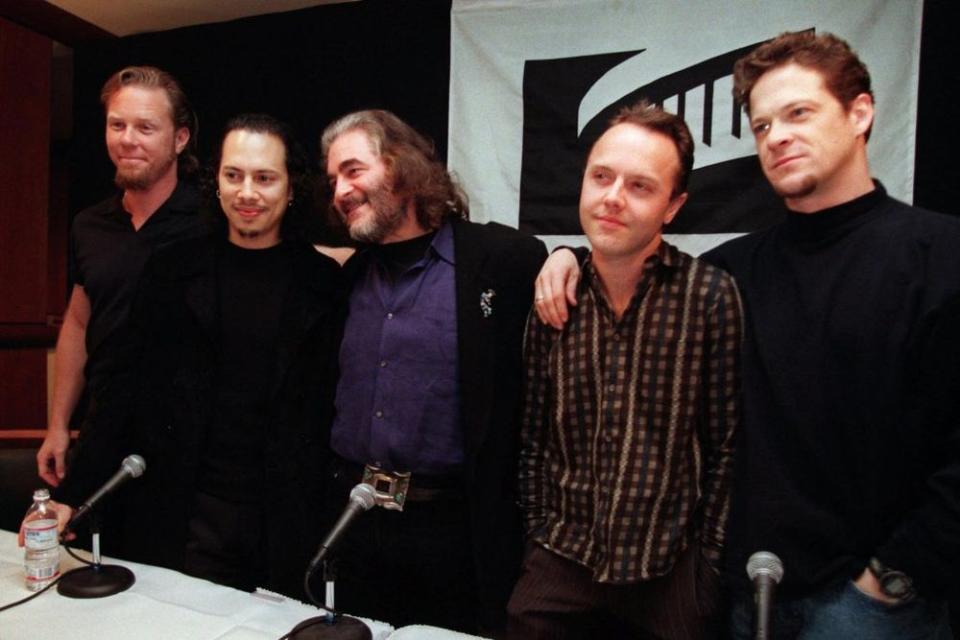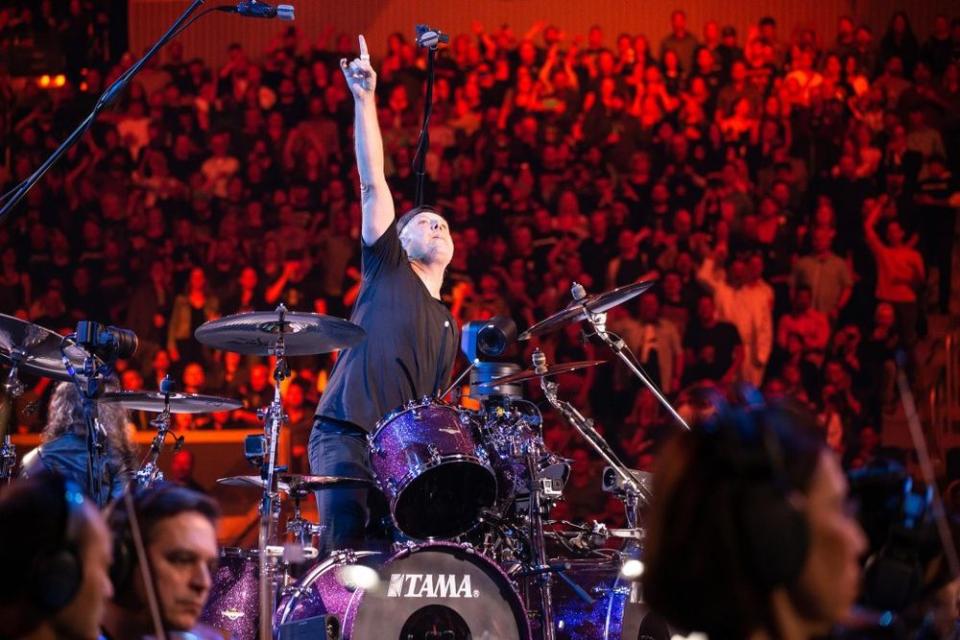For S&M2, Metallica aimed to balance the past and present
The members of Metallica are known as notorious perfectionists. Why, then, would they perform two arena concerts with a symphony, then allow themselves less than a month to turn the filmed footage into a full-length concert movie/documentary? “All those questions seem to be way more appropriate after the fact,” laughs drummer Lars Ulrich, who formed the Bay Area band in 1981 with singer-guitarist James Hetfield. “It’s that Metallica spirit — jump, and we’ll figure out where we’re going to land as we’re midway through free-falling.”
S&M² (Symphony and Metallica²), recorded over two nights in September at San Francisco’s brand-new Chase Center, hits theaters today for a one-night-only showing. The speedy timeline allowed the film to “get out there while it was still fresh and riding the energy of the event,” explains Ulrich, instead of “‘We’ll put it out next year after a bunch of people spend three months editing and speaking and going over every single frame.’”
It’s the second time the 2009 Rock & Roll Hall of Fame inductees have performed with the San Francisco Symphony (hence S&M²); the first was in 1999 and conducted by the project’s brainchild, Michael Kamen, who passed way in 2003. The most recent run of shows was overseen by Michael Tilson Thomas, in his final season as San Francisco Symphony Music Director. Thomas began the project with the band around March 2019 and conducted part of the concert, along with guest conductor Edwin Outwater.

Not wanting a rehash of their 1999 performance, Ulrich and crew culled and added to the set list. “Let’s say there were 20 songs in 1999. We said, ‘let’s pick the 10 best ones that sound the most relevant, the freshest, or the ones that we just feel good about whenever we’re listening.’ So we discarded half of them from ’99, and then we picked from albums post that project, around eight or 10 songs that we felt would lend themselves to this kind of interpretation.”
The 17 songs that made the cut into the 2-hour-and-39-minute film feature tunes from the band’s entire career — early chestnuts including “Master of Puppets,” “For Whom the Bell Tolls,” and the Grammy Award-winning “One,” plus songs released since 1999, like “The Day That Never Comes” and two from their most recent project, 2016’s Hardwired… to Self-Destruct: “Halo on Fire” and “Moth Into Flame.”
The process, explains Ulrich, “felt like a balancing act between the past and the present. Metallica always likes to keep looking into the future and try to make sure that these things always feel fresh and always have that kind of moving forward so it doesn’t just become these nostalgic exercises.”
Also different this go-round was the addition of bassist Robert Trujillo, who joined in 2003, replacing Jason Newsted, who performed on the original S&M. (Guitarist Kirk Hammett rounds out the band.) The new shows also serve as a tribute to the band’s original bassist Cliff Burton, who was killed in a 1986 tour bus accident. His signature solo, on 1983’s “(Anesthesia) – Pulling Teeth,” was played by the orchestra’s principal bassist, Scott Pingel.
“It was such an incredible tribute and such a standalone thing,” says Ulrich. “Robert respectfully felt that he had nothing that he could add to that. With Scott, it was such a home run. The fans just lapped that up and were, I think, not prepared for the emotional depth that this piece went to.”

Lending both continuity and freshness were the members of the Symphony themselves; Ulrich says about 30 to 40 percent were also on the 1999 recording. The drummer notes that 20 years ago, the four members of Metallica were among the youngest people on stage.” “Now, us being in our mid-’50s, a lot of the players in the orchestra are younger than we are,” he says. “So there’s a different kind of energy.” Plus he notes, “When you talk to some of these fine musicians, [for] a lot of them, Metallica’s actually been part of their musical growth, of their musical journey.”
Metallica, who has sold nearly 120 million albums worldwide, planned to continue their own touring journey on October 17 in Perth, Australia. However, on September 27, Ulrich, Hammett, and Trujillo called off the the shows due to Hetfield having to re-enter rehab. In a post on the band’s website, they wrote, “As most of you probably know, our brother James has been struggling with addiction on and off for many years. He has now, unfortunately, had to re-enter a treatment program to work on his recovery again.” The band members apologized to fans, saying they’re “devastated” to inconvenience “especially our most loyal fans who often travel great distances to experience our shows. We appreciate your understanding and support for James.”
Ulrich says that for now, after S&M2 makes its theatrical debut, Metallica will look at other outlets for the film and music. “Nothing’s confirmed yet, but we’re definitely looking at all options. We just wanted to get this movie out now, then we’re going to try to figure out if there’s any more things we can share with the fans and people at large.”
So, will Ulrich be heading to a local theater to watch himself on the big screen? “I’ll probably hide in some theater somewhere…or maybe just hide! I don’t know. One of the two.”
For ticket and theater information on Metallica’s S&M2, head here.
Related content:

